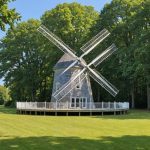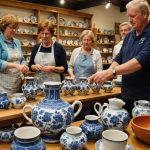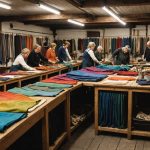Overview of British Textile Dyeing Workshops
British textile dyeing workshops offer an enriching cultural experience, drawing enthusiasts from around the world eager to dive into traditional techniques. Participants immerse themselves in the historic practice of British textile dyeing, which has been a cornerstone of the UK’s cultural heritage for centuries.
Traditional Techniques and Materials
Workshops focus on age-old methods that leverage both natural and synthetic dyes, embracing the authenticity of textile craftsmanship. Natural dyes are derived from plants, flowers, and insects, each contributing unique hues to the fabric, reflecting the deep relationship between nature and textile art. Simultaneously, synthetic dyes, introduced during the industrial revolution, provide a palette of vibrant colors that revolutionized the dyeing landscape.
Have you seen this : Discover the Enchanting UK Towns Where Traditional British Tales Come Alive
Cultural Significance
Textile dyeing holds a significant spot in Britain’s rich tapestry of traditions. Not only does it encapsulate the essence of British cultural heritage, but it also serves as a cultural experience that connects the past with the present. By participating, individuals gain insights into historical dyeing processes and their evolution, contributing to the preservation of these skills.
Workshops offer an immersive experience, allowing participants to engage directly with the materials, tools, and methods passed down through generations. This hands-on approach ensures that each attendee leaves with a deeper understanding and appreciation of the intricate art of British textile dyeing.
In parallel : Explore the Fascinating World of British Ceramics: Engaging Guided Tours in Stoke-on-Trent for Inquisitive Travelers
Techniques and Methods in Textile Dyeing
Embarking on the journey of dyeing techniques involves a fascinating exploration of both natural and synthetic methods, each with its own significance and artistry. These techniques embody the essence of textile craftsmanship that participants discover during workshops.
Natural Dyeing
Natural dyeing methods utilize dyes sourced from plants, flowers, and insects, capturing nature’s palette. Workshops frequently celebrate these techniques by demonstrating how to extract and apply colours like indigo, madder, and woad. One notable example is a workshop where attendees learn the intricate process of creating natural dyes using local flora, deepening their understanding of sustainable practices.
Synthetic Dyeing
In contrast, synthetic dyeing revolutionized the craft with vibrant, long-lasting colours, offering a broader spectrum than natural dyes. Introduced in the industrial era, these dyes brought a new dimension to textile dyeing. Workshops dedicated to synthetic dyeing focus on teaching modern techniques, analysing differences in durability, and vibrant results compared to natural methods.
Stamping and Resist Techniques
Incorporating stamping and resist techniques enhances the artistic value of fabrics. These methods involve applying special pastes or wax to create unique patterns and textures. Workshops often delve into the historical context of these practices, offering participants hands-on experience in crafting intricate designs that echo traditional artistry.
Featured Locations for Workshops
Textile workshops across the UK attract numerous enthusiasts, acting as both classrooms and cultural hubs. One remarkable city is Bristol, renowned for its thriving arts scene and vibrant textile dyeing workshops. Here, participants can enjoy a blend of traditional and contemporary techniques in an inspiring environment. Bristol’s eclectic atmosphere makes it a perfect choice for those interested in experiencing the full spectrum of dyeing arts.
Another popular destination is Edinburgh, where history and modernity converge seamlessly. Workshops in this scenic city frequently offer exclusive seasonal activities, such as dyeing fabric with local flora during spring or using traditional Scottish patterns. This seasonal appeal enhances the overall cultural experience, and participants often combine workshops with sightseeing, enriching their visit.
Leeds offers another prominent choice, known for its rich industrial past and textile heritage. The city’s workshops offer accessibility with numerous transport options, and local cafes and accommodations make for a comfortable stay.
Visitors can plan their trips to coincide with workshops, taking advantage of nearby amenities for a seamless experience. By choosing a city that aligns with their interests, tourists can dive deeper into British textile artistry while exploring the broader cultural landscape.
Scheduling and Costs of Workshops
Participating in a British textile dyeing workshop requires thoughtful planning around scheduling and costs. Workshops vary in length, typically ranging from a half-day to several days, accommodating diverse participant interests and schedule constraints. Class sizes can influence the experience significantly; smaller groups ensure personalized attention, while larger ones may offer broader social interactions.
Costs associated with workshops depend on duration, materials, and instructor expertise. Introductory workshops usually have lower fees, covering basic materials, while advanced sessions may require a higher investment due to specialised resources and skilled guidance. Participants should budget accordingly, noting any additional costs for materials not included.
When planning to attend, it’s wise to book early as popular workshops fill quickly, especially those featuring renowned instructors or unique themes. Bookings can often be secured through workshop websites or by contacting venues directly. Flexibility in scheduling may open opportunities for last-minute participation if spots become available.
To ensure a successful booking, it’s beneficial to research workshop reviews and reach out to past attendees for insights on their experiences, focusing on the quality of instruction and overall satisfaction. This preparation guarantees a worthwhile investment in the workshop experience.
Learning Outcomes and Participant Expectations
Engaging in a British textile dyeing workshop offers invaluable learning outcomes, blending artistry with cultural experiences. Participants can anticipate mastering various textile skills, gaining a thorough understanding of both traditional and contemporary techniques. From handling natural dyes like woad and madder to exploring synthetic dye innovations, learners delve into the essence of textile craftsmanship.
The role of instructor expertise is paramount, significantly impacting the participant experience. Workshops led by seasoned practitioners ensure that attendees receive comprehensive instruction, enabling them to replicate techniques confidently. Instructors often bring unique insights and industry knowledge, enriching the educational journey.
Testimonials reveal the transformative nature of these workshops. One participant praised the hands-on approach, noting, “I left with not only new skills but a profound respect for the craft.” This sentiment echoes throughout the textile community, highlighting the enrichment such workshops offer beyond technical proficiency.
Participants are encouraged to embrace curiosity, ask questions, and engage deeply with the materials and processes. This proactive involvement fosters a deeper appreciation of the craftsmanship involved and ensures a rewarding and fulfilling experience for both newcomers and seasoned enthusiasts alike.
Historical and Cultural Significance of Textile Dyeing
The textile history of Britain is deeply enriched by centuries of traditional dyeing practices. These techniques underpin the cultural significance of British traditions, reflecting the evolution of societal and artistic expressions through fabric. Textile dyeing emerged as a critical craft during the industrial revolution, paving the way for Britain’s reputation as a textile powerhouse.
Regional variations across the UK highlight diverse approaches to dyeing, influenced by geography and local resources. Scottish tartans, for instance, are emblematic of regional identity, showcasing unique dyeing techniques tailored to distinct clan patterns. Such diversity not only reinforces local heritage but also enhances the depth of British textile artistry.
In contemporary times, these traditional methods have gained relevance within the sphere of sustainable practices. Workshops often emphasize the use of eco-friendly materials, preserving the heritage craft while adhering to modern environmental standards. This dual focus on tradition and innovation demonstrates the enduring impact of historical dyeing methods, allowing them to resonate with today’s ethical and cultural consciousness. Engaging in these practices offers participants a glimpse into the past, fostering a profound appreciation for the craft and its significance within the tapestry of British traditions.
Tips for Tourists to Maximize Their Experience
Engaging in a British textile dyeing workshop offers more than artistic exploration; it provides a robust cultural experience. To truly maximize this opportunity, preparation is key. Before attending a workshop, familiarize yourself with the traditions of British textile dyeing. This could involve reading about the techniques and materials you will encounter.
When attending a workshop, it’s important to leave comprehensive notes and ample space in your luggage. Participants often bring home samples, and understanding them deeply can enrich your travel experience. Considering the immersive nature of these activities, layering them with local exploration ensures you absorb both craft and culture. Explore nearby historical sites or museums that offer insight into the British textile heritage.
Additionally, engage with locals and workshop instructors to gain a deeper understanding of the historical context. Their perspectives often weave personal stories into the fabric of your learning. Finally, combine your visit with tours and events in the area. By amalgamating your workshop with local cultural activities, you not only enhance your appreciation for the craft but also establish a holistic experience that reflects British traditions.











